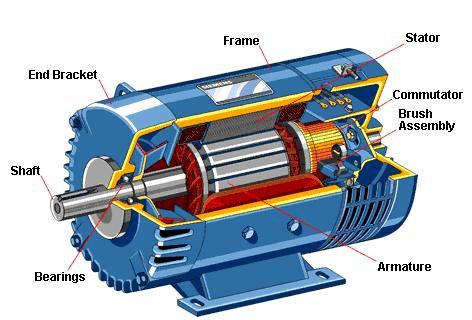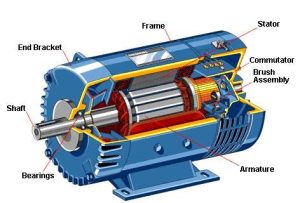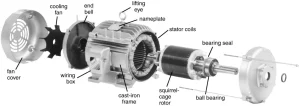Three-phase induction motors are at the heart of modern marine engineering, playing a pivotal role in powering critical systems onboard ships. Renowned for their durability, efficiency, and reliability, these motors are integral to various applications, from propulsion systems to auxiliary machinery. Their widespread adoption in the maritime industry reflects their ability to deliver consistent performance under challenging operational conditions.
A three-phase induction motor operates on the principles of electromagnetic induction. It converts electrical energy into mechanical energy, which is then used to power various shipboard systems. Unlike synchronous motors, induction motors do not require additional external excitation for their rotor, making them simpler, more robust, and cost-effective.
Design and Construction of Three-Phase Induction Motors
A three-phase induction motor comprises two main components:
- Stator: The stationary part of the motor, consisting of laminated steel cores with windings connected to a three-phase power supply. When energized, these windings produce a rotating magnetic field.
- Rotor: The rotating part, usually made of laminated steel and conductive bars. The interaction between the rotor and the stator’s magnetic field induces current in the rotor, generating torque.
Two primary types of rotors are used in three-phase induction motors: Squirrel Cage Rotor, known for its simplicity, durability, and low maintenance requirements, this type is most commonly used in maritime applications, and Wound Rotor, equipped with windings and external resistances, this type allows for better control of starting torque and speed but is less common due to its complexity.
Functionality and Working Principle
The operation of a three-phase induction motor begins when a three-phase alternating current (AC) is supplied to the stator windings. This current creates a rotating magnetic field in the stator. The relative motion between the stator’s magnetic field and the rotor induces a current in the rotor conductors, producing a secondary magnetic field. The interaction between these fields generates torque, causing the rotor to rotate. One of the defining characteristics of an induction motor is the slip, which is the difference between the speed of the stator’s magnetic field (synchronous speed) and the rotor’s speed. A small slip is essential for maintaining the induction process, ensuring efficient energy conversion.
Applications of Three-Phase Induction Motors on Ships
Three-phase induction motors are ubiquitous in the maritime industry, powering a diverse range of systems. Their applications span propulsion, auxiliary systems, and deck machinery, highlighting their versatility and reliability.
– Propulsion Systems : In modern ships, electric propulsion systems often use large three-phase induction motors. These motors are preferred for their ability to provide smooth torque and speed control, essential for efficient vessel maneuvering and energy savings. For instance, in diesel-electric propulsion systems, generators powered by diesel engines supply electricity to large induction motors driving the propellers. Case Study: The Azipod system, widely used on cruise ships and icebreakers, employs three-phase induction motors integrated into steerable pods. This configuration enhances maneuverability, reduces fuel consumption, and minimizes vibration, offering an optimal solution for high-performance vessels.
– Auxiliary Systems: Three-phase induction motors power various auxiliary systems critical to shipboard operations, including:
- Pumps: For ballast water, fuel, and firefighting systems.
- Fans: For ventilation and air conditioning.
- Compressors: For refrigeration and pneumatic systems.
- Winches and Cranes: For cargo handling and anchoring.
Example: Cargo Handling Systems On container ships, three-phase induction motors drive cranes and winches, ensuring the efficient loading and unloading of cargo. Their reliability and low maintenance requirements make them ideal for these high-demand applications.
– Deck Machinery: Deck machinery, such as mooring winches, windlasses, and capstans, relies heavily on three-phase induction motors for their operation. These motors provide the necessary power and torque to handle heavy loads, ensuring safe and efficient mooring and anchoring procedures.
Advantages of Three-Phase Induction Motors in Marine Applications
Three-phase induction motors offer numerous advantages that make them indispensable in marine engineering:
- High Efficiency: These motors convert electrical energy into mechanical energy with minimal losses, reducing operational costs and improving energy efficiency.
- Durability: Designed to withstand harsh marine environments, including high humidity and saltwater exposure, three-phase induction motors are built to last.
- Low Maintenance: With no brushes or commutators, these motors require minimal upkeep, ensuring reliability in continuous operations.
- Cost-Effectiveness: Their simple construction and widespread availability make them an economical choice for shipowners and operators.
- Versatility: Suitable for a wide range of power ratings and applications, from small auxiliary systems to large propulsion units.
Challenges and Considerations
While three-phase induction motors offer numerous benefits, certain challenges must be addressed to optimize their performance in maritime applications:
- Starting Current: Induction motors require a high inrush current during startup, which can strain the ship’s electrical system. Soft starters or variable frequency drives (VFDs) are often used to mitigate this issue.
- Harmonics and Power Quality: The use of VFDs can introduce harmonics into the electrical system, affecting power quality. Proper filtering and system design are essential to minimize these effects.
- Cooling Requirements: Efficient cooling is critical to prevent overheating, especially in high-power applications. Marine environments necessitate robust cooling solutions, such as water-cooled systems, to ensure reliable operation.
Case Studies Demonstrating Impact
On liquefied natural gas (LNG) carriers, three-phase induction motors drive cargo pumps responsible for transferring LNG between tanks and terminals. These motors are designed to operate reliably in cryogenic conditions, ensuring the safe and efficient handling of LNG cargoes.
Icebreakers operating in polar regions depend on three-phase induction motors for propulsion. These motors provide high torque at low speeds, allowing vessels to break through thick ice sheets. The Arctic-class icebreaker “Polar Star” utilizes induction motors designed to withstand sub-zero temperatures and extreme mechanical stress.
Future Trends and Innovations
The maritime industry is witnessing several advancements that will further enhance the performance and efficiency of three-phase induction motors:
- Integration with Smart Systems: Sensors and IoT-enabled monitoring systems are being integrated into motors to enable real-time performance analysis and predictive maintenance.
- Improved Materials: Advances in materials science, such as high-performance laminations and advanced insulation, are increasing motor efficiency and reducing losses.
- Hybrid and Electric Ships: The shift towards hybrid and fully electric vessels is driving innovation in motor technology, with a focus on high-efficiency designs and compatibility with renewable energy sources.
Three-phase induction motors are indispensable components of modern ships, providing reliable, efficient, and cost-effective solutions for a wide range of maritime applications. From powering propulsion systems to driving auxiliary machinery, these motors have proven their versatility and resilience in the demanding marine environment. As the maritime industry embraces digitalization and sustainability, the role of three-phase induction motors is set to expand further. Innovations in materials, design, and integration will enhance their performance, ensuring they remain a cornerstone of marine engineering for years to come. By understanding the design, functionality, and applications of these motors, maritime professionals can better appreciate their critical role in ensuring safe and efficient ship operations.



